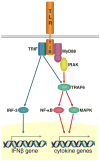The role of Toll-like receptors in CNS response to microbial challenge
- PMID: 16899072
- PMCID: PMC2423668
- DOI: 10.1111/j.1471-4159.2006.04076.x
The role of Toll-like receptors in CNS response to microbial challenge
Abstract
The recent discovery of the family of Toll-like receptors has vastly expanded our understanding of the mechanisms by which the innate immune system recognizes and responds to a wide variety of microbial and endogenous pathogens. Toll-like receptors are transmembrane proteins that upon ligation with their cognate ligands trigger the production of cytokines, enzymes and other inflammatory agents. In the CNS Toll-like receptors are expressed predominantly by glial cells. In particular, the vastly abundant astrocytes are likely to be the major contributors to inflammatory responses within the CNS. Studies of the murine brain abscess model revealed that Toll-like receptor 2 plays a pivotal role in the generation of immune responses to Staphylococcus aureus. Although Toll-like receptor signaling is essential in antimicrobial defense, it may also lead to bystander injury of CNS tissue.
Figures

Similar articles
-
Role of astroglial toll-like receptors (TLRs) in central nervous system infections, injury and neurodegenerative diseases.Brain Behav Immun. 2021 Jan;91:740-755. doi: 10.1016/j.bbi.2020.10.007. Epub 2020 Oct 8. Brain Behav Immun. 2021. PMID: 33039660 Free PMC article. Review.
-
Toll-like receptors in health and disease in the brain: mechanisms and therapeutic potential.Clin Sci (Lond). 2011 Nov;121(9):367-87. doi: 10.1042/CS20110164. Clin Sci (Lond). 2011. PMID: 21745188 Free PMC article. Review.
-
Toll-like receptors in defense and damage of the central nervous system.J Neuroimmune Pharmacol. 2007 Dec;2(4):297-312. doi: 10.1007/s11481-007-9071-5. Epub 2007 Apr 3. J Neuroimmune Pharmacol. 2007. PMID: 18040848 Review.
-
Innate immunity and neuroinflammation in the CNS: the role of microglia in Toll-like receptor-mediated neuronal injury.Glia. 2010 Feb;58(3):253-63. doi: 10.1002/glia.20928. Glia. 2010. PMID: 19705460 Review.
-
The innate immunity of the central nervous system in chronic pain: the role of Toll-like receptors.Cell Mol Life Sci. 2007 May;64(9):1128-36. doi: 10.1007/s00018-007-6494-3. Cell Mol Life Sci. 2007. PMID: 17440679 Free PMC article. Review.
Cited by
-
Peripheral blood RNA gene expression profiling in patients with bacterial meningitis.Front Neurosci. 2013 Mar 18;7:33. doi: 10.3389/fnins.2013.00033. eCollection 2013. Front Neurosci. 2013. PMID: 23515576 Free PMC article.
-
Role of the cathelicidin-related antimicrobial peptide in inflammation and mortality in a mouse model of bacterial meningitis.J Innate Immun. 2014;6(2):205-18. doi: 10.1159/000353645. Epub 2013 Aug 22. J Innate Immun. 2014. PMID: 23969854 Free PMC article.
-
Prophylactic and therapeutic targeting of the neurokinin-1 receptor limits neuroinflammation in a murine model of pneumococcal meningitis.J Immunol. 2011 Jun 15;186(12):7255-63. doi: 10.4049/jimmunol.1100721. Epub 2011 May 11. J Immunol. 2011. PMID: 21562162 Free PMC article.
-
Diagnostic accuracy of presepsin (sCD14-ST) for prediction of bacterial infection in cerebrospinal fluid samples from children with suspected bacterial meningitis or ventriculitis.J Clin Microbiol. 2015 Apr;53(4):1239-44. doi: 10.1128/JCM.03052-14. Epub 2015 Feb 4. J Clin Microbiol. 2015. PMID: 25653398 Free PMC article.
-
Multidrug-Resistant Pseudomonas aeruginosa Evokes Differential Inflammatory Responses in Human Microglial and Retinal Pigment Epithelial Cells.Microorganisms. 2020 May 14;8(5):735. doi: 10.3390/microorganisms8050735. Microorganisms. 2020. PMID: 32423093 Free PMC article.
References
-
- Akira S. Toll-like receptors and innate immunity. Adv Immunol. 2001;78:1–56. - PubMed
-
- Akira S, Takeda K, Kaisho T. Toll-like receptors: critical proteins linking innate and acquired immunity. Nat Immunol. 2001;2:675–680. - PubMed
-
- Akira S, Uematsu S, Takeuchi O. Pathogen recognition and innate immunity. Cell. 2006;124:783–801. - PubMed
-
- Alexopoulou L, Holt AC, Medzhitov R, Flavell RA. Recognition of double-stranded RNA and activation of NF-kappaB by Toll-like receptor 3. Nature. 2001;413:732–738. - PubMed
-
- Baldwin AC, Kielian T. Persistent immune activation associated with a mouse model of Staphylococcus aureus-induced experimental brain abscess. J Neuroimmunol. 2004;151:24–32. - PubMed
Publication types
MeSH terms
Substances
Grants and funding
LinkOut - more resources
Full Text Sources
Other Literature Sources

